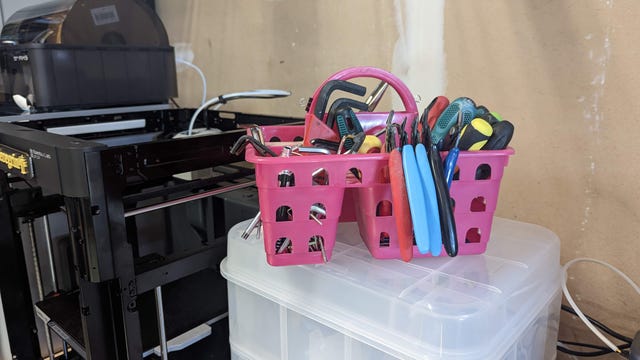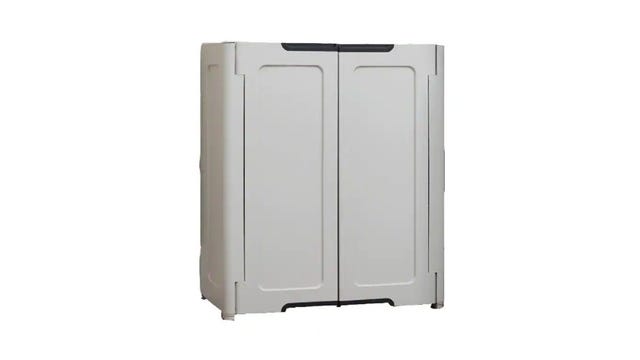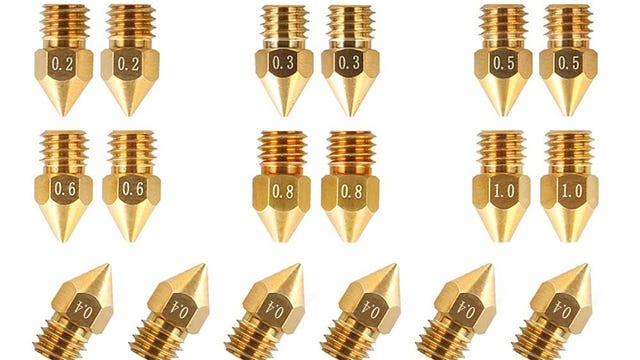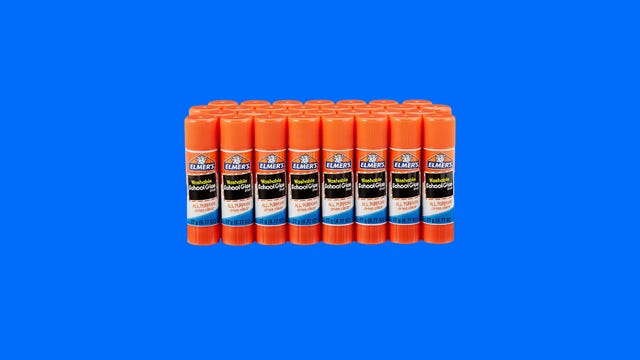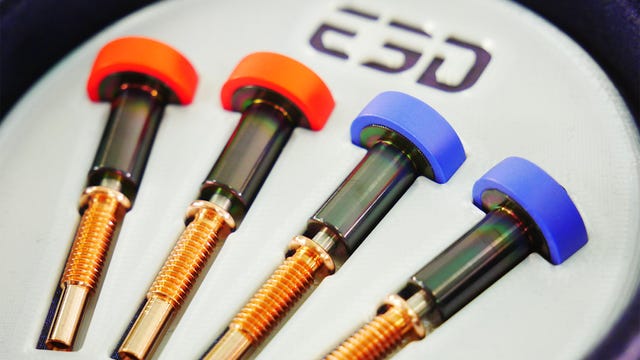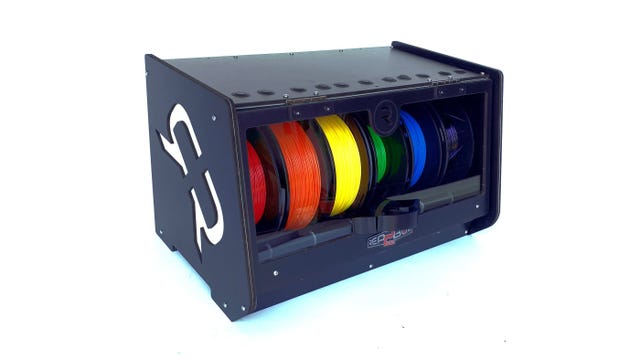Technologies
Best 3D-Printing Accessories: Make the Most of Your 3D Printer
From tiny 3D-printer scrapers to giant machines, we have everything you need to level up your 3D-printing experience.
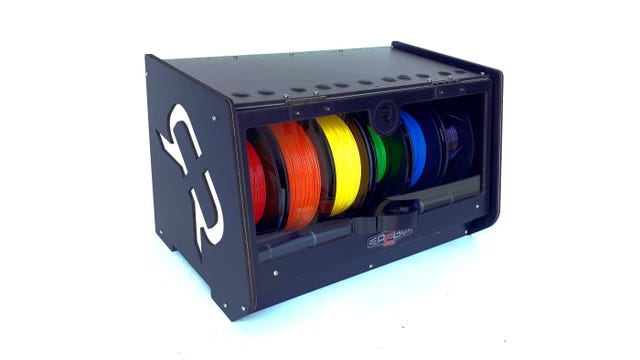
With some hobbies, extra tools and accessories can make them even more fun. 3D-printing is one, and the addition of a good set of extras will make your 3D-printing time much easier. Often these accessories are simple — a set of snips for cutting filament or a bit of glue to help bed adhesion — but there are also new pieces of hardware that can significantly improve your print quality or give your 3D printer powers it never had before. More than that, though, good accessories can make even the best 3D printers run above and beyond their normal scope.
I’ve amassed a huge number of helpful accessories after nearly a decade of 3D printing and have researched many others. Amazon is a great resource for finding basic 3D-printing accessories, and California-based MatterHackers has everything you need for more advanced upgrades and gear.
Best accessories for beginners
While every 3D printer comes with a paint scraper that you can use to remove models from the build plate, not all are created equal. Most 3D printer scrapers don’t allow you to get the blade low enough to lift a model without damaging the build surface. I use the Buildtak 3D printer scraper because it can swipe under the model without gouging down, making them pop right back up.
These little storage caddies are incredibly helpful for more than just storing shower products. The separate compartments make it easy to store all of your hex key wrenches, scrapers and filament cutters in a way that makes it easy to move them around your workspace with the handy handle. I have three of these in my workshop and I use them for 3D-printing tools, assorted glues and sandpaper. It makes life a lot easier.
A digital caliper is a helpful 3D-printing accessory, especially if you’re creating your own models. Most can measure details down to a thousandth of a millimeter, which lets you design with a high degree of accuracy.
Having a set of calipers also helps you measure your prints to make sure they’re printing in the correct size and shape.
Having a central place to store your materials is important to keep them safe and dry. These cabinets from Home Depot are expandable and easy to build. They’re perfect for stacking your filament or resins safely, and if you add a small dehumidifier or desiccant packets, you can keep everything dry, too.
Most 3D printers come to you with a 0.4mm nozzle, which is fine for most uses. There are a lot of cool projects you can make with larger nozzles, though: Try making thick vases using a 0.8mm nozzle or detailed miniatures with a 0.2mm nozzle. Having a variety of nozzles will expand your horizons to no end.
These Mk8 nozzles are designed for the Creality Ender 3, but many printer companies either use the same Mk8 nozzles or variety packs of their own.
Magigoo is like a glue stick on steroids. It is specifically designed to hold 3D prints to the build plate while printing but comes loose easily when the bed is finally cooled. It’s incredibly satisfying to print models that are barely touching the build surface that act like they are held down with cement. A small bottle goes a long way too, so it’s worth the price.
Did you know that the 3D-printing community uses so much Aqua Net hairspray that Amazon’s «Frequently bought together» section shows filament and replacement printer beds? Aqua Net is used as a transition adhesive that both helps your filament stick to the build plate, and when it gets cold, makes it easier to remove. You have to be careful not to spray it onto any moving parts, but if you take off your removable build plate and spray it gently and evenly you will see better results immediately.
Models often have sharp edges when they first come off of the build plate, especially if you’ve used a brim to anchor them down. A deburring tool like this smoothes those edges with a simple swipe across the corner. It takes a little getting used to, but if you’re making something for people to handle, a deburring tool is a must.
If you live here in the US, you may well have a set of hex wrenches that you use for most things. However, 3D printers are made using metric measurements, and not inches, so they will either be loose and damage the nut or not fit at all. A good set of metric hex wrenches are affordable and make 3D printing easier.
Desiccant is a much needed tool in the fight against moisture. Even the best 3D-printing filament can be degraded by absorbing too much moisture, and if you live in a damp climate, storing your filament in a cool dry place with a desiccant pouch is a great way to keep it usable for longer. These pouches are a little pricier than some, but they can be recharged by heating them up so you can use them again and again.
Like the hairspray, glue sticks help hold a print down, while also adding a barrier between the print and the plate. Some materials stick a little too well to a build plate and can tear a mat or even crack a glass plate. Glue sticks are water soluble too, so it’s easy to wash off with soap and water.
Accessories for intermediate and advanced users
If you’re hoping to print a filament like ABS, you’ll need your 3D printer to be very hot with no breezes. If you live in a particularly cold climate an enclosure is a helpful way to warm up the area around your 3D printer without having to pay a fortune on heating bills. The Wham Bam HotBox has two sizes, so even if you have a bigger machine you can reap the benefits of a warmer build area.
One of the best upgrades to be released in recent years is the Revo rapid change system from E3D. Available for a huge number of 3D printers, this hotend replacement adds the ability to quickly swap out your nozzles without the use of wrenches and pliers. You can remove the filament, let the nozzle cool down and twist it off with your fingers.
Being able to easily swap nozzles opens up new printing techniques with larger nozzles for strength and smaller ones for detail. It is a must-do upgrade for any compatible machine.
Nozzles are consumable in 3D printing and you can expect to use them up fairly frequently. If you print materials with abrasive materials such as carbon fiber, wood or even glow in the dark, your nozzle could be destroyed in just one eight-hour session. The ObXidian nozzle is specially hardened to reduce wear and tear and keep your nozzle printing for much longer.
It’s also a part of the Revo system I just mentioned, so can be easily swapped out for different sizes or other nozzles easily.
The Palette 3 is a multimaterial unit that lets your standard 3D printer print multiple colors or types of filament. It opens up a huge amount of variety in your 3D printing and can help you create a truly unique model. You can even take an existing digital model and «paint» colors onto it so that when it prints, it is a multitude of — well up to eight — colors.
The RepBox is a community favorite for a number of reasons. The creator is an awesome advocate for 3D printing and the box itself is a fantastic design that can be mounted or sat on a workbench. The RepBox holds six 1kg rolls of filament and comes with several dehydrating cases to keep them fresh. The filament is fed out of the box directly into a Palette system or multiple printers without ever touching the moist air.
3D printer accessories FAQ
What’s the best 3D-printing tool for beginners?
When you first start 3D printing, the most important thing to get right is your first layer. It takes time to get the build plate level enough to print consistently, so any tool that can help with that is important. Any of the bed adhesives in this list will help your first layer lay down better, and make it easier to remove the print once it is done.
Glue sticks and hairspray may seem like low-tech solutions for a high-tech machine, but they work and they’re cheap.
How does nozzle size affect 3D printing?
Nozzle size determines how much material you can push through at any given time. The standard nozzle has a 0.4mm hole in it, but there are nozzles available from 0.2mm to 0.8mm and beyond. A good rule of thumb is that if you want a stronger print, go big, and if you want detail, go small.
I would say that there is a move to replace 0.4mm nozzles with 0.6mm nozzles as a standard, as you lose very little detail in the change, but the models print quicker and tend to be stronger too.
More on 3D printing
Technologies
Today’s NYT Mini Crossword Answers for Thursday, Jan. 8
Here are the answers for The New York Times Mini Crossword for Jan. 8.

Looking for the most recent Mini Crossword answer? Click here for today’s Mini Crossword hints, as well as our daily answers and hints for The New York Times Wordle, Strands, Connections and Connections: Sports Edition puzzles.
Need some help with today’s Mini Crossword? I found 6-Across to be especially tricky. Read on for all the answers. And if you could use some hints and guidance for daily solving, check out our Mini Crossword tips.
If you’re looking for today’s Wordle, Connections, Connections: Sports Edition and Strands answers, you can visit CNET’s NYT puzzle hints page.
Read more: Tips and Tricks for Solving The New York Times Mini Crossword
Let’s get to those Mini Crossword clues and answers.
Mini across clues and answers
1A clue: Donate
Answer: GIVE
5A clue: Piece of equipment in curling or Quidditch
Answer: BROOM
6A clue: Tidbit of information
Answer: DATUM
7A clue: Prone to daydreaming
Answer: SPACY
8A clue: Athletic shorts fabric
Answer: MESH
Mini down clues and answers
1D clue: Flavor of a purple lollipop
Answer: GRAPE
2D clue: Greek letter I’s
Answer: IOTAS
3D clue: Go to bat (for)
Answer: VOUCH
4D clue: Award with Daytime and Primetime categories
Answer: EMMY
5D clue: Erotic practice in «Fifty Shades of Grey,» for short
Answer: BDSM
Don’t miss any of our unbiased tech content and lab-based reviews. Add CNET as a preferred Google source.
Technologies
New Foldable Phones Are Already Shaking Up the 2026 Smartphone Market
Commentary: Company announcements, analyst data and rumors of a foldable iPhone all point to an ambitious year for this still-young category.

What used to be a niche phone design is starting to flex its way into the mainstream. Foldable phones, which incorporate two or three panels that open into tablet configurations or condense down into compact sizes, are finding their audience. At CES 2026, for instance, Motorola announced its entry into with the book-style Razr Fold and Samsung showed off its Galaxy Z TriFold. Just as important, overall the category is seeing double-digit growth forecasts in 2026.
According to a December report from market research company IDC, global foldable phone shipments were expected to grow 10% in 2025 compared to 2024. And that number will continue to grow in 2026, with an expected 30% year-on-year jump, thanks to rumors of an upcoming foldable iPhone from Apple. And even though Samsung’s Flip and Fold phones have been around for years, the company’s newer TriFold and rumored «Wide Fold» have me hyped for what’s to come in 2026.
On the other hand, Huawei has led the way with innovative products, including its own trifold that beat Samsung to the category — the Huawei Mate XT — as well as a one-of-a-kind wide-screen flip phone, the Huawei Pura X. It dominated China’s foldable phones market with a massive 68.9% market share in the third quarter of 2025, according to a report from IDC (via MyDrivers). This is huge for a single brand in any market, especially when a niche category like foldables has several competitors (Oppo, Vivo, Xiaomi and more).
These new foldable phone styles, along with the rumored iPhone Fold from Apple — which is said to have a passport-size design — could mean we’ll see four different types of foldable phones by 2026, giving people more options for compact devices that unfold into larger screens.
The four kinds of foldable phones to expect in 2026
So far, the most popular foldable phones have been book-style (like the Galaxy Z Fold 7) and flip phones (like the Motorola Razr). While the former is a phone that unfolds into a mini-tablet, the latter folds into a more pocketable design. Both designs have their benefits, but if rumors are true, there are more ways to build a folding phone.
2026 will see two new designs in the category, and one of them has already been launched in several markets. Here’s why I think all these new foldable phones will have an audience.
Flip phones
The Galaxy Z Flip 7 and Motorola Razr lineups are built for those who want a compact phone without compromising on screen size. Not everyone has massive pockets in their jeans but that doesn’t mean they need to settle for a smaller screen. These flip phones are designed to be more pocketable while also offering the same 6.9-inch display as a regular slab phone.
Book-style foldables
The Samsung Galaxy Z Fold 7, Google Pixel 10 Pro Fold, Oppo Find N5 and Honor Magic V5 are all book-style foldables, which unfold to a mini-tablet. I like this design because I love browsing the web and reading on my phone and the squarish aspect ratio when unfolded makes it an excellent e-reader.
Recent developments in battery tech (silicon-carbon anode batteries) and hinge design have allowed manufacturers to shrink the crease depth and overall thickness to make them almost as slim as regular slab phones. These phones typically have big screens that aren’t ideal for videos, due to thick letterboxing. But they can be propped up by themselves, so you don’t need an external kickstand to watch 21:9 or 16:9 videos.
Book-style foldable phones are made for those of us who want to be more productive on a phone without needing a separate device.
The trifolds
This is the most versatile foldable phone design as of now and its best examples include the recently launched Samsung Galaxy Z TriFold and the Huawei Mate XT. However, not all trifolds are designed the same.
The Huawei trifold is the most versatile phone I’ve ever used, allowing me to use it as a phone, a mini tablet and a wide-screen 16:11 tablet for productivity and media consumption. It’s a true all-in-one device that delivers everything in a portable design.
By comparison, the Galaxy Z Trifold gives you a wide-screen 10-inch tablet that fits in your pocket and can also be used as a phone. It doesn’t offer a mini-tablet mode — you can use it either folded as a phone or fully unfolded — but Samsung’s trifold is designed as a productivity and media powerhouse. It’s essentially a flagship Galaxy Tab S-style device that fits inside your pocket.
Widescreen foldables
The Huawei Pura X is the best example of a wide-screen foldable so far. While some might argue that the first-generation Oppo Find N and Google Pixel Fold could fit under this category, their inner screens were also squarish (8.4:9 on the Oppo phone and 5:6 on the Pixel Fold); they were smaller book-style foldables.
In contrast, the Pura X has a 6.3-inch display with a wider 16:10 aspect ratio, which makes it an ideal screen for reading and watching videos. I used the phone recently for a few days and it’s the best combination of pockatability and versatility. You can watch videos with minimal letterboxing (thick black borders on top and bottom) on its 16:10 screen or use it like an e-reader in vertical orientation. And for the times when you need to snap some selfies using the rear cameras, you get a decent viewfinder in the form of a big cover screen — without making the phone unwieldy like book-style foldables.
Apple is rumored to adopt this approach with its upcoming iPhone Fold, but with a bigger cover screen. And Samsung is said to be developing a similar «Wide Fold» that’ll give you a 4:3 inner screen, too. According to a report from ETnews, this new Samsung foldable could have a 5.4-inch cover screen and support 25-watt wireless charging.
If the Korean company launches it alongside a presumed Galaxy Z Fold 8 and Flip 8, potentially in July 2026, it would launch ahead of Apple’s rumored foldable, which is presumed to launch in the fall.
While these foldable phones will likely be expensive — especially the newer trifold and wide fold shapes — they’re bringing a lot of new competition to a phone market that’s otherwise dominated by the candy bar shape. As we move into 2026, I’m looking forward to having multiple size, design and functionality options, much like we do with traditional phones.
Technologies
Speediance Unveils New Compact Resistance Trainer and Wearable
Speediance is aiming to make strength training more portable with a wearable unveiled at CES.
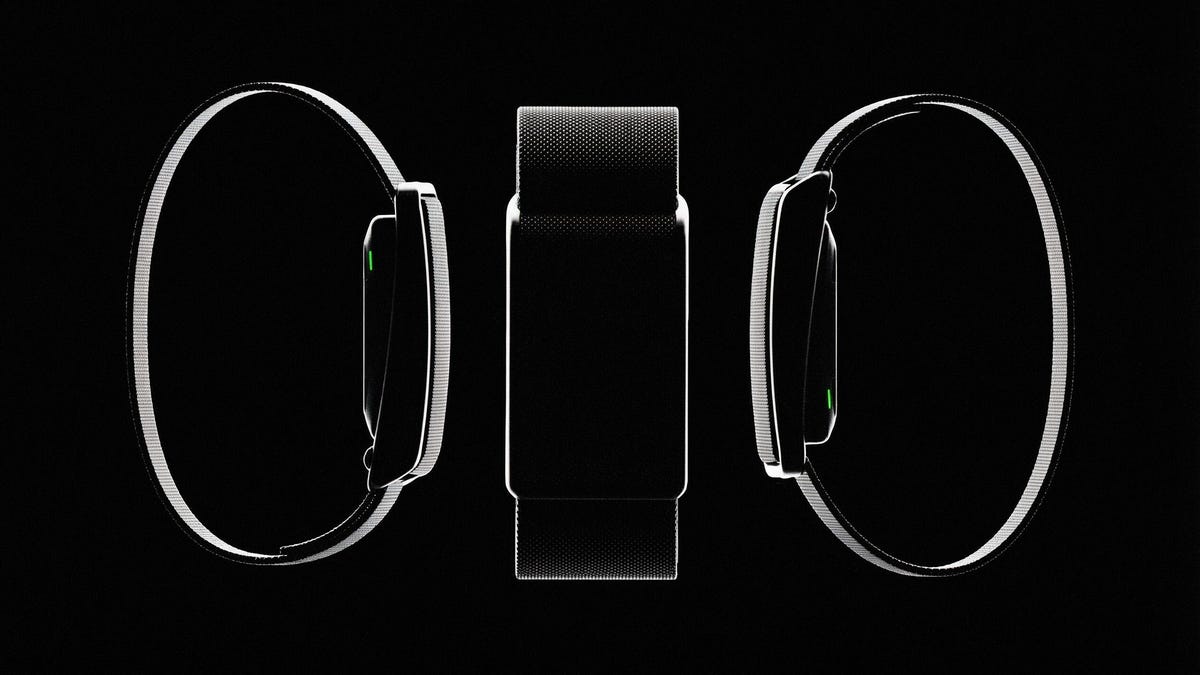
Speediance unveiled its new Gym Nano and Speediance Strap products this week at CES 2026. The smart fitness equipment manufacturer, which previously developed its own smart home gym, the Gym Monster 2, designed the Gym Nano and Speediance Strap to complement its current equipment ecosystem.
«Rather than developing products in isolation, we’re building a comprehensive training and health ecosystem that adapts to users’ real lives and empowers better decision-making over time,» Speediance founder and CEO Liu Tao said in a statement.
Speediance used the consumer tech expo in Las Vegas to demonstrate the Gym Nano, a portable, motor-driven cable resistance training system designed to occupy minimal space for those who prefer to work out at home. The strap is a prototype wearable device designed to read your health data and provide training recommendations based on this insight.
CNET previously tested Speediance’s VeloNix AI Smart Bike and named it the best AI-powered exercise bike.
Don’t miss any of our unbiased tech content and lab-based reviews. Add CNET as a preferred Google source.
Gym Nano
The Gym Nano is a compact digital cable resistance machine trainer that fits any space and delivers full-body workouts. It’s meant to make strength training at home easier if you have limited space and can’t commit to larger home gym equipment.
The Gym Nano offers up to 220 pounds of resistance through adjustable 1-pound increments. It also has five dynamic weight modes: Eccentric, Chain, Standard, Fixed Speed and Sled.
Speediance Strap
The Speediance Strap is a screen-free wearable that collects data related to your sleep, training and core body temperature. It then uploads and shares this data to the Speediance Wellness Plus app, where it makes suggestions for your daily training and recovery based on this information.
The strap can be used for both endurance and strength training activities and recognizes various types of exercises, movement patterns, training volume and other insights that can help you learn how well your body is responding to your training.
The Speediance Strap is a screen-free wearable that collects data related to your sleep, training and core body temperature. It then uploads and shares this data to the Speediance Wellness Plus app, where it makes suggestions for your daily training and recovery based on this information. Similar to other wearables, the Speediance Strap assesses your readiness each day and can detect stress factors to determine if you should focus more on recovery on that day.
«With Speediance Strap, we are exploring how wearable data can function as part of a decision-support layer within a connected fitness system, rather than existing as isolated metrics,» Tao said in a statement.
Additionally, everyday insights (like core and recovery data) will be free to you unless you want to upgrade to the Wellness Plus access, which will come at an additional cost to receive long-term insights and AI planning.
It’s unclear when the Gym Nano will be available for purchase, but the Speediance Strap is expected to launch through a Kickstarter campaign in spring 2026.


